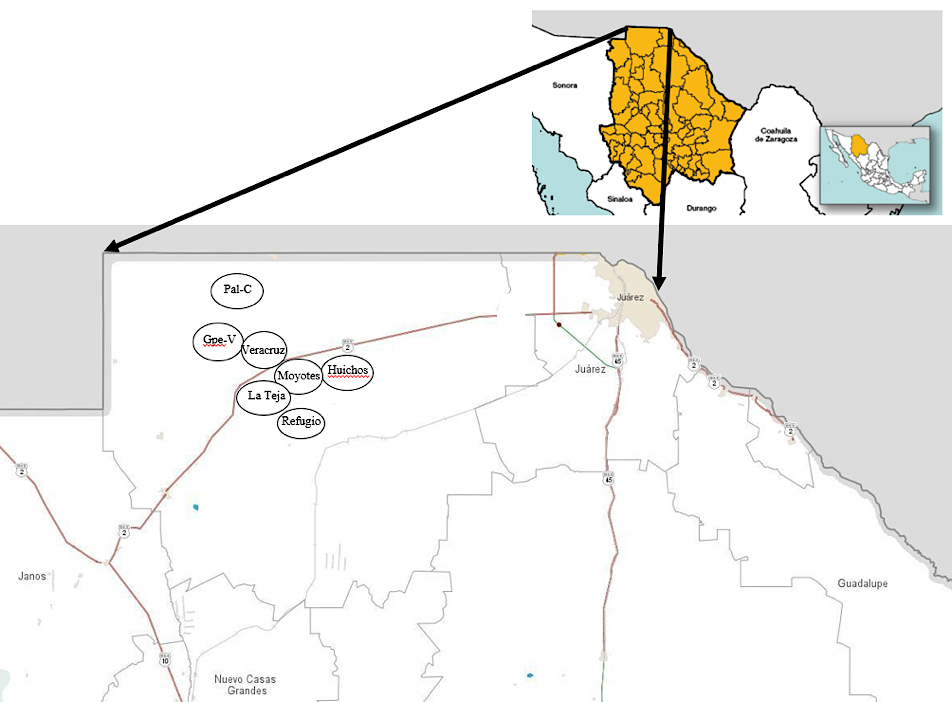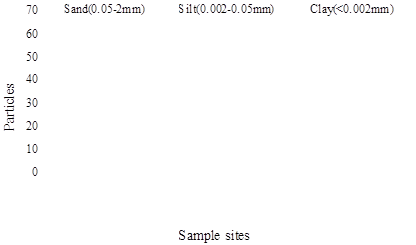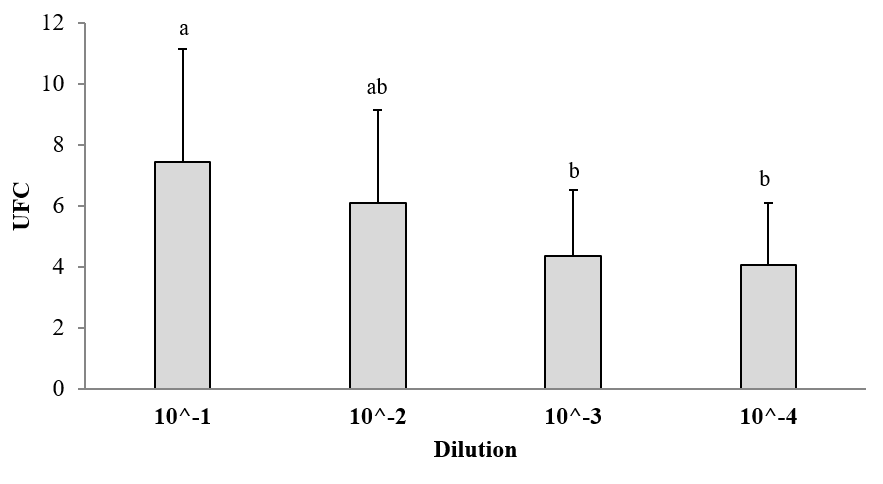Introduction
Identification of fungi in soil surface at the sources of windblown dust in desert areas requires attention to understand the main effect of serious microorganisms on human health as result of people being exposed to airborne particles through inhalation. Although there are many studies that indicate several fungal genera in soils of desert areas of the world and their transport during dust storms (Kellogg et al., 2004), there is a lack of information on the adjacent areas of United States of America (USA) and Mexico (MX) characterized by the desert climate. Two million people are exposed several times a year to airborne particles due to the dust storms in the Paso del Norte region that covers the Northern Chihuahua, MX, southern New Mexico, USA and southwest Texas, USA (Flores et al., 2014; González et al., 2017; Kavouras et al., 2016). The exposition impact on people can be severe because particulate matter dispersed in the air transport spores and minerals large distances which cause more people is affected (Al-Subai, 2002).
A pioneer study at Ciudad Juárez, Chihuahua, MX, reported that Alternaria, Aspergillus, Cladosporium, and Penicillium were common fungal microorganisms allergenic in air samples from indoors and outdoors areas (Olivas et al., 1993). Recently, an evaluation of fungus in the Chihuahuan desert that used the sticky tape method reported that Alternaria, Penicillium and Fusarium were relatively more frequent than other microorganisms found as fungus in soils collected from USA sites, and Alternaria and Aspergillus had higher presence during analysis than other fungal microorganisms in soils from Mexican areas. Alternaria, Penicillium and Aspergillus were the three genera of airborne fungal microorganisms frequently detected in USA and Mexican areas (González et al., 2017). Scott and Zobeck (2009) indicated that fungal spores, bacteria, and viruses are an important and significant threats to economic agriculture and human health, for instance dust studied in Arizona, USA, where Leathers (1981) found 16 species of fungus that were identified from spores analysis as human pathogens, thus valley fever is a disease caused by the fungus Coccidioides immitis, and it is causing more than 27 human deaths in Arizona annually.
Another relevant issue associated with wide environments consists of fungal diversity in saline soils as Great Salt Plains where Evans et al. (2013) found that fungal species as Aspergillus and Penicillium have been the dominant genera in hypersaline fungal communities, also commonly observed are Alternaria, Chaetomium, Cladospirium, Eurotium, Fusarium, Mucor and Rhizopus among other. Also, Aspergillus, Cladosporium, and Penicillium were detected as the most common fungi from 12 026 air samples across the United States (Shelton et al., 2002). However, a lot of studies have been done in the Middle East in hypersaline systems (Mandeel, 2006), also soil fungal from the Sonoran Desert has been isolated (Ranzoni, 1968) classified as Xerophilic fungi that growth under limited water conditions as arid soils, also predominant in the Chihuahuan desert present in north Chihuahua, Mexico and southwest USA, Paso del Norte region, where Calcisol (Aridisols) soils have pH from 7.5 to 8.7, electrical conductivity from 0.6 to 2.2 dS m-1, and soil moisture content lower than 4% at 3 cm soil depth (Flores et al., 2014).
Aspergillus are commonly soil fungi or saprophytes, and they are having impact on diseases in poultry, plants, insects, human and other mammal’s. Relevant species are A. candidus, A. clavatus, A. flavus, A. fumigatus, A. niger, and A. nomius. This fungus are important aeroallergens, and produce mycotoxins that include aflatoxins, cyclopiazonic acid, patulin, gliotoxin, among others toxic metabolic, thus aspergilli could be mutagenic or carcinogenic in animals (Wilson et al., 2002). As dust storms occur usually during winter and spring seasons, they are impacting large cities as Ciudad Juarez, Chihuahua, Las Cruces NM, and El Paso TX, where airborne particulate matter (MP2.5) have been counted and are overlapping maximum limits of the Mexican regulations (SSA, 1994; Hernández et al., 2013). As a result, an increase of breathing diseases as asthma and many respiratory complications are recorded in health institutions (Hernández-Cadena et al., 2000; Sarnat et al., 2012). As particulate matter dispersed to air contains several organic and inorganic components, fungal microorganisms play an important role on human health. For this reason, this study had the objectives of determining the main fungal genera that are present in arid soils where dust storms are originated, and generate information of this kind of microorganisms that are transported and mostly inhaled during dust storms.
Materials and Methods
Site of study
The study sites were located Northwest of the state of Chihuahua, Mexico, at the municipalities of Ascension and Juarez along the USA-Mexico border (Figure 1, Table 1). The experimental sites were located in Palomas (Pal-C), La Teja, Guadalupe Victoria (Gpe-V), Huichos, Refugio, Veracruz and Moyotes. All sites were identified as the point sources of dust storms, using satellite maps reported by Lee et al. (2009), and Rivera-Rivera et al. (2010). The sites were verified at the field level prior to sampling. As predominant wind direction is west (Flores et al., 2014), many urban and rural areas of the Paso del Norte region receive dust from these sources (Rivera-Rivera et al., 2009; Flores et al., 2011; 2014). According to INEGI (2017) the soil units predominant in the region of the current study are Arenosol, Calcisol, Regosol, Solonetz, and Solonchak (Figure 2). This region includes cities of Las Cruces, NM, El Paso, TX, and Ciudad Juarez, Chihuahua with more than two million people. Digital pictures were taken at each site to register the area without vegetation, landscape characteristics, and presence of dust storms during sampling activities.
Table 1: Geographic coordinates for the sites sampled in north of Chihuahua state, Mexico.
| Location | Latitude | Longitude |
| Gpe-V | 31º 31’ 15.12” | 107º 43’ 6.87” |
| Huichos | 31º 31’ 47.66” | 107º 14’ 43.29” |
| La Teja | 31º 29’ 57.28” | 107º 26’ 16.75” |
| Moyotes | 31º 30’ 55.36” | 107º 18’ 27.67” |
| Pal-C | 31º 43’ 2.47” | 107º 29’ 48.71” |
| Refugio | 31º 26’ 28.08” | 107º 26’ 24.52” |
| Veracruz | 31º 31’ 11.58” | 107º 27’ 36.93” |
Soil sampling
A total of 234 soil samples were taken at 3 cm soil depth using a small auger at all seven dust-source sites during the spring season in 2014 mostly. Number of samples varied from 25 to 45 per site depending on area covered, and area at each site varied from 1 to 10 km2; at each site, surface samples were collected each 10 m using a random method covering cardinal points. Samples were placed in Ziploc® plastic bags and placed in coolers to be taken to the laboratory. Three composite soil samples containing 100 g from each site were separated for fungal analysis. Additional soil samples were air-dried and sieved at 2 mm particle diameter for analysis of gravimetric water content and analyze particle size distribution based on the hydrometer method (Gee and Bauder, 1986).
Fungal analysis of soil samples
From each sampling area and based on composite sample, about 10 g of soil from the air-dried sample was added into a 250 mL flask containing 100 mL of distilled water. This flask was placed on a stir plate and mixed at 500 rpm for three minutes. Then, 9 mL of distilled water was poured in each of four test tubes. They were labeled as 10-2, 10-3, 10-4 and 10-5 to point each dilution. From each flask was collected 0.001 L of solution and poured to the tube labeled “10-2” and thoroughly mixed. After that, same volume of solution from this test tube was added to another labeled as “10-3”, and so on until all dilutions were done. Thus, 0.001 L of each dilution was pipetted onto an Acidified Potato Dextrose Agar (APDA) and was spread over the surface using a glass rod. Each petri box was labeled with appropriate dilution, treatment, and date, and two petri boxes per dilution level were used. Preparations were incubated at room temperature (20-24 °C), and on the 10th day the fungal colonies were counted. To compute the number of microorganisms, the number of colonies (NC) was counted on all petri boxes at each dilution level, and an average number of colonies (ANC) were obtained as ANC = NC/number of plates used. The ANC was multiplied by the dilution factor to obtain the number of colonies per gram of dry soil. The identification of isolated fungal microorganisms was done using a Motic microscope at illumination Köhler at 40 X as classic method based on morphological attributes as hyphae and spores (Navy et al., 1999; Serrato and French et al., 2009; Eroglu et al., 2012).
Statistical analysis
One-way analysis of variance was used to detect significant variation in measured soil moisture, and fungal colonies in Petri dishes. Post-hoc, pairwise comparisons were performed using LSD test, normality test for data was conducted using Kolmogorov-Smirnov method, using software SPSS version 21.0.
Results and Discussion
Physical and chemical characteristics of soil
On average, soil moisture was very low and it varied from 1.5 to 4.0% (Figure 3). No rain was observed several days prior and during the soil-sampling mostly in spring season, but highest air temperature was 40 °C during sampling, which is predominant in these desert areas. Statistically, the locations Huichos and Veracruz had the highest moisture content; in contrast, the site Pal-C had the lowest moisture content values, because of less vegetation present around the sampled places. Significant effect was detected (P < 0.01) for soil moisture among locations, but there was no statistical difference (P = 0.052) among soil samples within locations.
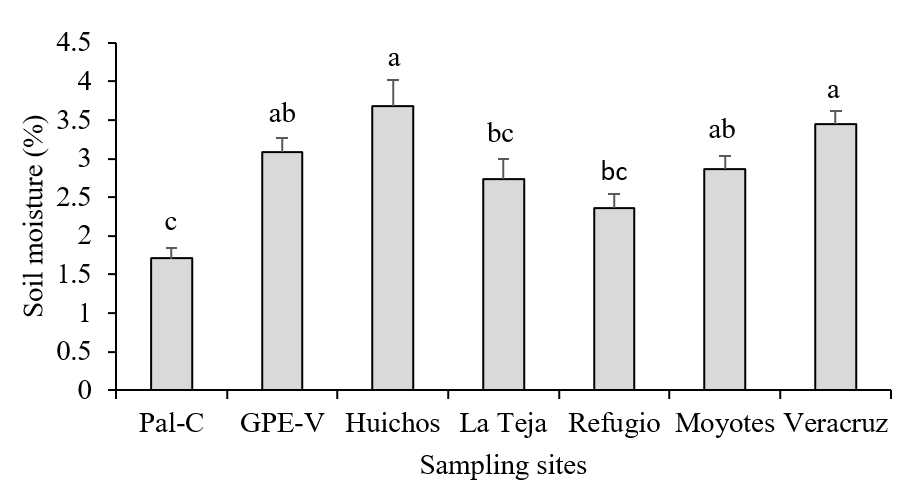
Figure 3: Averages of soil moisture at 0 to 3 cm depth for eight locations in areas of the Chihuahuan desert. Small bar are standard errors (P < 0.05).
Regarding soil texture, the statistical analysis did show significant differences among particles sizes of sand, and silt, but not for clay content among sites (P > 0.05) (Table 2). Also, textural classes based on soil classification showed significant differences among sites. The observed predominant textural groups were clay-loam in six sites, and sandy clay loam in two sites (Table 3).
Table 2: Analysis of variance for soil texture and moisture in sites where dust storms are originated in the Chihuahuan desert of North in 2014.
| Source of variation | Degrees of freedom | Sum of squares | Mean square | F | p-value |
| Soil moisture | |||||
| Sites | 7 | 86.95 | 12.42 | 14.768 | 0.000**† |
| Samples | 14 | 20.37 | 1.455 | 1.73 | 0.052 |
| Error | 203 | 170.75 | 0.841 | ||
| Total | 224 | 282.13 | |||
| Sand content | |||||
| Sites | 7 | 2952.94 | 421.84 | 2.506 | 0.028* |
| Error | 48 | 8081.32 | 168.36 | ||
| Total | 55 | 11034.26 | |||
| Silt content | |||||
| Sites | 7 | 2383.62 | 340.51 | 3.349 | 0.005** |
| Error | 48 | 4881.02 | 101.68 | ||
| Total | 55 | 7264.64 | |||
| Clay content | |||||
| Sites | 7 | 691.38 | 98.76 | 0.61 | 0.745 |
| Error | 48 | 7775.07 | 161.98 | ||
| Total | 55 | 8466.46 | |||
† Significant observed level: P < 0.05 is significate effect, and P < 0.01 is highly significant.
Table 3: Soil textural groups detected in the sites sampled where dust storm are originated.
| Site | Soil textural group |
| Con-Pal | Clay loam |
| Mpa | Clay loam |
| La Teja | Clay loam |
| Moyotes | Clay loam |
| Veracruz | Sandy clay loam |
| Huichos | Sandy clay loam |
| GPE-V | Clay loam |
Regarding soil particles size distribution, the highest sand percentage was observed in site “Huichos”, however largest silt and clay contents was observed in site “GPE-V” (Figure 4). Both soil moisture and soil textural classes in surface areas subjects to wind effects, can be considered as key factors to correlate the dust storms in terms of frequency and intensity, also to obtain predictive models for the amount of particle matter dispersed to the air, and estimate Aeolian erosion in desert areas (Schwartz et al., 1996; Flores et al., 2011; Kavouras et al., 2016).
Number of fungal colonies (UFC) and main fungal genus frequency in soils
Significant difference was detected among averages of UFC for the sites and dilutions used during counting of colonies (P < 0.05) (Table 4). The UFC average among sites varied from three to nine including all dilutions. The amount of UFC on average was significantly higher for the sites Veracruz, Moyotes, Refugio, and Huichos (P < 0.05, Figure 5). This can be explained as these sites have more livestock presence and plant cover. The sites La Teja and Palomas had the lowest UFC as compared to the rest of sites because they have a large area of soil without vegetation.
Table 4: Analysis of variance for number of fungal colonies detected in soils, for the effects between locations and dilutions.
| Source of variation | Degrees of freedom | Sum of squares | Mean square | F | p-value |
| Site | 7 | 3033.0 | 433.2 | 2.614 | 0.011† |
| Dilution | 3 | 1365.9 | 455.3 | 2.747 | 0.042 |
| Site × Dil. | 21 | 3883.6 | 184.9 | 1.116 | 0.324 |
| Error | 904 | 149839.8 | 165.7 | - | - |
| Total | 935 | 158105.6 | - | - | - |
† Significant observed level: P < 0.05 is significate effect, and P < 0.01 is highly significant.
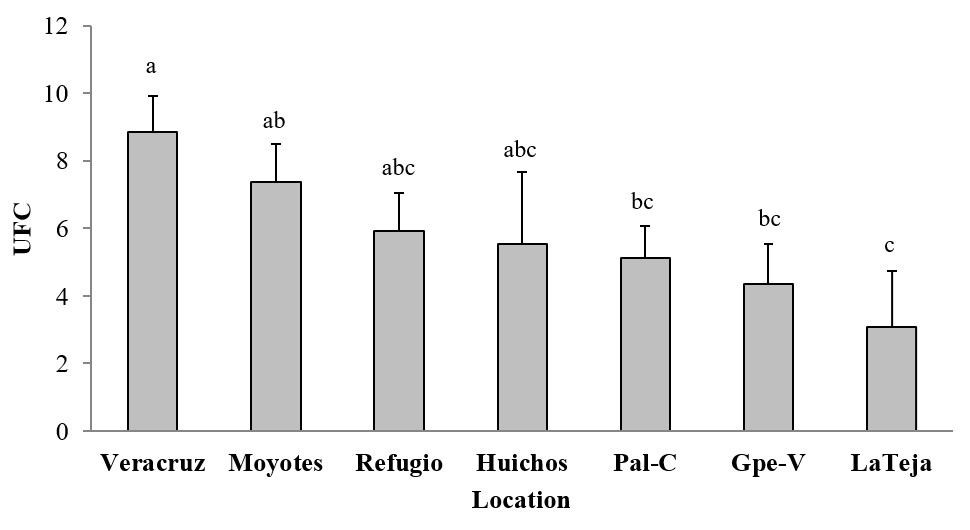
Figure 5: Average of number of colonies observed in all sites. UFC means Colony Unit Forming. Letters indicate differences among site (P < 0.05).
On average, the number of UFC decreased from 4.1 to 7.4 for 10-1 to 10-4, respectively, which indicates that all dilutions were well conducted in the laboratory. Statistically, the UFC was similar for all dilutions 10-1 and 10-2 (P < 0.05). For these dilutions, the NC was higher than the others (Figure 6), as these are normally more concentrate in this type of microbial analysis.
Table 5 shows that there is not significant difference for sum of UFC among sites (P > 0.05). However, the means comparison test showed statistical difference (Figure 7). Total sum of UFC varied from 9 to 25, where the sites Veracruz, Moyotes, and Refugio were significantly higher, but site La Teja had the lowest amount of fungal colonies, which can be attributed to a soil with poor vegetation and highly aerolian.
Table 5: Analysis of variance for the sum of UFC among sites, this data includes three petri dishes and 10 replications for all dilutions and sites evaluated (n = 312).
| Source of variation | Degrees of freedom | Sum of squares | Mean square | F | p-value |
| Site | 7 | 8034.9 | 433.2 | 1147.8 | 0.051† |
| Error | 304 | 171826.9 | 165.7 | 565.2 | - |
| Total | 311 | 179861.9 | - | - | - |
† Significant observed level: P < 0.05 is significate effect.
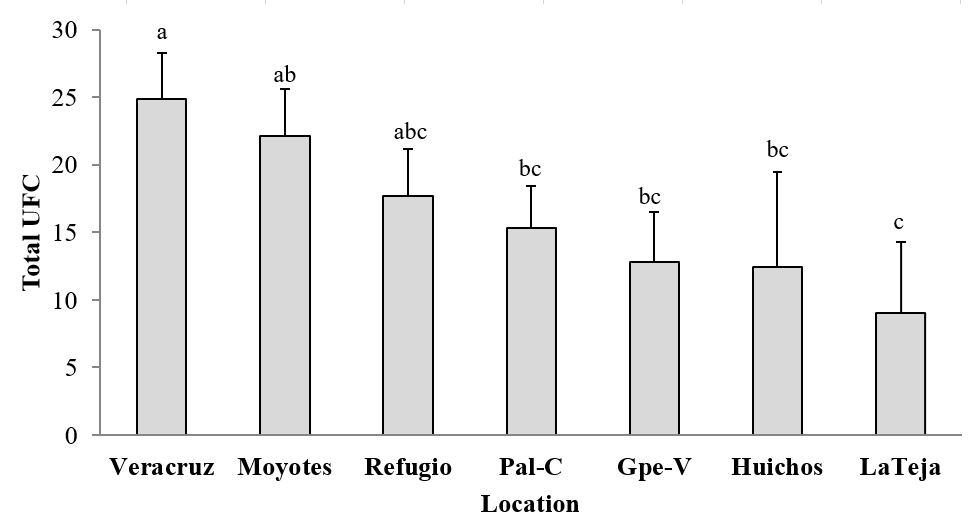
Figure 7: Average of the total sum of number of colonies among sites, this analysis includes three petri dishes and 10 replications for all dilutions and sites evaluated (n = 312).
The technique of decimal dilutions and plate count is simple to perform; however its use is limited by the selected substrate. No difficulties were observed with the technique due to the used references for fungal identification that indicated that the APDA (acid potato dextrose agar) was the correct substrate for the development of fungal colonies in this study. The APDA provides good results for fungal colonies that could be easily dispersed in the substrate, due to the dispersal of spores from one or different individuals after transferring the sample from the aliquot to the substrate. Davet and Rouxel (2000) reported that the decimal dilutions and plate count method overestimate the abundance of species that produce large spore quantities. Therefore, the count of fungal colonies obtained though decimal dilutions were considered unappropriated and excluded in this study, however the frequency of fungal colonies was reported since it is independent from the isolation method.
Significant differences were detected between fungal genera found in soil samples (P < 0.05), but no differences were found between sites and the interaction genus times sites (P > 0.05) (Table 6). The fungal frequencies varied from 3 to 20 among sites, thus Veracruz had the largest frequency. In contrast, the sites Huichos and La Teja had the smallest genera percentage. The genus Aspergillus sp. had highest frequency and abundant (35%) among the eight sites, followed by Rhizopus sp. (13%), from 5 to 10% were Phytium sp., Alternaria sp., Bipolaris sp., Phoma sp., and Acremonium sp. Fungal genus with frequency lower than 5% were Penicillium sp., and Fusarium sp. (Figures 8 and 9). The adaptive properties of Penicillium sp., and Fusarium sp. are not as effective for the desert conditions as presented by Aspergillus sp. that has more dispersion capacity in soils, as reported in other studies where Aspergillus, Eurotium, and Penicillium sp., has been isolated. Anthrinium, Cladosporium, Debaryomyces, Fusarium, and Ulocladium has been indicated as important in the great salt plains of Oklahoma that is near Chihuahuan desert (Evans et al., 2013).
Table 6: Analysis of variance for the fungal presence ong sites in soil samples where dust storms are originated in the north Chihuahuan desert in 2014.
| Source of variation | Degrees of freedom | Sum of squares | Mean square | F | p-value |
| Sites | 7 | 707.625 | 101.089 | 0.388 | 0.909† |
| Fungal genera | 13 | 7223.315 | 481.554 | 1.847 | 0.027 |
| Sites × Fungal | 60 | 8934.056 | 148.901 | 0.571 | 0.995 |
| Error | 348 | 90712.184 | 260.667 | - | - |
| Total | 431 | 147492.000 | - | - | - |
† Significant observed level: P < 0.05 is significate effect.
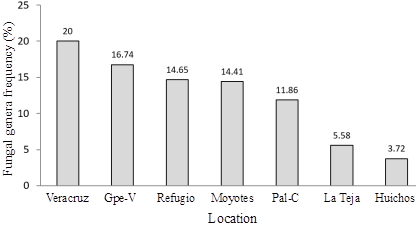
Figure 8: Frequency of fungal genus presence in all sites studied at the north Chihuahuan desert in Mexico.
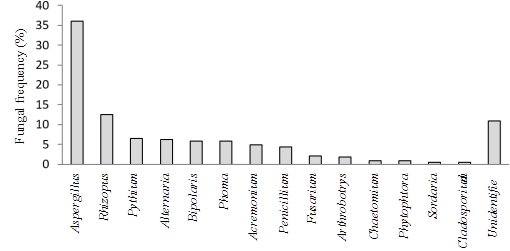
Figure 9: Frequency of fungal genera detected in soil samples where dust storms are originated in the north Chihuahuan desert in 2014.
Undoubtedly, inhalation of fungal spores or hyphal fragments is the most known exposure route to pathogenic fungal agents responsible of causing allergic respiratory responses (Chapman et al., 2003; Condemi et al., 2003). Allergic respiratory responses take place after the IgE recognizes molecules such as glycoproteins, proteins and polysaccharides present in fungal spores or hyphae. In this study, Alternaria was one of the fungal genus found in various sampling locations with arid soils which are characteristics of the northern desert of the state of Chihuahua. Particularly, Alternaria was etiologically evaluated and associated to asthmatic reactions that could lead to serious asthma crisis in children and young adults (Ruiz y Rodríguez, 2006), also this genus is contributing to allergic reaction, rhinitis and asthma indoors (Fung et al., 2000). Other fungal genus as Bipolaris is reported in pathological studies on the measurement of the paranasal sinuses, and other diseases as nasal obstruction and purulent nasal discharge (Taguchi et al., 2007). Another common fungus observed was Phytium that is often pathogenic to many plants and animals (Lumsden et al., 1976).
The most common genera detected in this study agree with the results reported by Olivas et al. (1993). For example, Aspergillus sp. showed greater frequency than Rhizopus sp., followed by the genera Phytium sp., Alternaria sp., Bipolaris sp., Phoma sp., and Acremonium sp., while Penicillium sp., Fusarium sp. had the least frequency among others. Similarly, Shelton et al. (2002) reported the same fungal genus for the far west and Midwest of the United States. The results suggest that there is no a characteristic microbiota in the soils of the northern desert of the state of Chihuahua. The imperfect melanic fungi are present in high frequency, however not necessarily in higher diversity compared to non melanic fungi. Many of the isolated micromycetes are distributed worldwide. This research generated information of fungal soil samples that are potentially transported in air, mostly at arid areas of the Chihuahuan desert where impact on two million people that is frequently affected by dust storms from February to April each year, and the fungal data can be strategy to assist medical evaluations and health hazards.
Conclusions
Most of the main sites where dust storms originated were located and sampled in Chihuahuan desert of northern Mexico. They presented poor vegetation, high Aeolian events during sampling activities, and low soil moisture content. Common soil textures were clay loam and sandy clay loam, but high variability in percentages of clay, silt, and sand. Fourteen fungal genera were detected, Aspergillus was the most frequent genus among the eight sites, followed by Rhizopus sp., and low presence of Phytium sp., Alternaria sp., and Bipolaris sp., among others was also detected. Soil characteristics and fungal genera found where dust storms are originated represent a tremendous importance for human health associated to breath diseases in large urban areas of northern Mexico and southwest USA. More studies should focus on determine fungal from genus to specie level, and collect samples from places under plants in shade areas at different seasons to develop strategies for improving quality of life in the area.
Data Availability
All data generated or analyzed during this study is included in this published article.
Authors Contributions
Juan Pedro Flores Margez, contributed to the conceptualization of the study, acquisition of funds, management and administration of the project, organization of the working group, analysis of data, writing of the report. Jaime Jiménez supports sampling, laboratory analysis and identification of fungal genera. Joel Hernández support in methodology, field sampling, sample analysis, data analysis, manuscript review. Evangelina Olivas supports laboratory analysis and identification of fungal genera. Pedro Osuna Avila, contributed to the review of the writing. Manoj Shukla, Amir González and Dave Dubois supported the conceptualization of the work, methodology and revision of the manuscript.











 text new page (beta)
text new page (beta)


